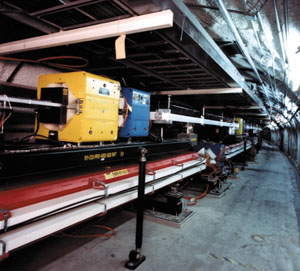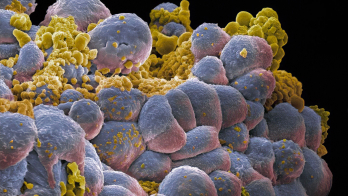
The PEP-II asymmetric B-factory at the Stanford Linear Accelerator Center (SLAC) continues to exceed expectations, having nearly reached its design performance after only a year of operations. This innovative electron-positron collider was designed and built by SLAC and the Lawrence Berkeley and Lawrence Livermore National laboratories with $177 million from the US Department of Energy, and it has been creating millions of B-meson pairs.
A collaboration of more than 500 physicists who designed and built the 1200 t BaBar detector is eagerly sifting through this burgeoning mountain of data. Coming to Stanford from Canada, China, France, the UK, Germany, Italy, Norway, Russia and all across the US, they are searching for evidence of CP violation – an asymmetry between matter and antimatter – in B meson decays.
As reported at the International Conference on High Energy Physics in Osaka, Japan (September p5), the SLAC B-factory recently hit a peak luminosity of 2.3 x 1033 cm-2s-1 – 76% of its goal of 3.0 x 1033. When combined with better than expected operating efficiencies on both the collider and the BaBar detector, this facility has exceeded its expected daily output of B-meson events on several different occasions. Having already created more than 10 million B-meson pairs, or more than has been recorded on all previous accelerators, it is indeed operating like a factory, thanks to the untiring efforts of the commissioning team, led by John Seeman.
A distinctive feature of the B-factory and the reason that it is called “asymmetric” is that the electrons and positrons circulate at different energies. When an electron and a positron meet and annihilate, the B meson and its antiparticle that are often produced lurch forward in the direction of the more energetic electron beam. This feature makes it much easier to isolate the daughter particles that arose from each of the two B decays and to determine the time that elapsed between them. Knowing this time difference is vital for physicists trying to measure any CP-violating asymmetries among B mesons.
Normally a new particle collider with such innovative features must be coaxed through a long tuning period, often taking several years, before it performs at its full potential. The particle detector surrounding the collision point is another complex, sensitive device that must be carefully adjusted to function as designed. However, the entire B-factory – both collider and detector – has come on line smoothly and in record time, to the delight of the hundreds of BaBar scientists now trying to cope with the flood of new data.
At Osaka, BaBar spokesman David Hitlin of Caltech presented results based on more than 9 million B-meson pairs. In addition to precision measurements of B meson lifetimes and mixing parameters as good as any that have been made by the CLEO collaboration at Cornell, he revealed a surprisingly large branching ratio for decays into pion pairs – more than twice the CLEO value. This preliminary result augurs well for further measurements of a possible CP asymmetry in these decays, but it must be confirmed by further measurements on BaBar and KEK’s Belle experiment.
By far the most anticipated number that Hitlin presented was the collaboration’s preliminary result for the CP violation parameter sin 2b, which is extracted from decays of neutral B and anti-B mesons into a J/psi particle and a short-lived neutral kaon. Any significant difference between these two decay rates corresponds to a non zero value of sin 2b and gives solid evidence for CP violation.
The preliminary value that Hitlin announced at Osaka, based on 120 such “golden events”, was 0.12 ± 0.37 (stat) ± 0.09 (syst) – consistent with no CP violation at all. However, the errors are large at this early stage. They will come down steadily as millions more B mesons are produced and recorded over the next few months. “The rapid launch of the B-factory has given us our first glimpse into the new domain of CP violation measurements in the B-meson system,” observed Hitlin. “We hope to double our data by the end of October and to begin to make truly definitive tests of the Cabibbo-Kobayashi-Maskawa mechanism for this intriguing phenomenon.”








